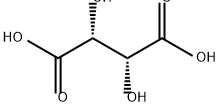| Chemical Properties | white crystals |
| Chemical Properties | Tartaric acid occurs as colorless monoclinic crystals, or a white or
almost white crystalline powder. It is odorless, with an extremely
tart taste. |
| Uses | L-(+)-Tartaric Acid is a naturally occurring chemical compound found in berries, grapes and various wines. It provides antioxidant properties and contributes to the sour taste within these products. |
| Uses | In the soft drink industry, confectionery products, bakery products, gelatin desserts, as an acidulant. In photography, tanning, ceramics, manufacture of tartrates. The common commercial esters are the diethyl and dibutyl derivatives used for lacquers and in textile printing. Pharmaceutic aid (buffering agent). |
| Uses | L-(+)-Tartaric acid is widely utilized in pharmaceutical industries. It is used in soft drinks, confectionaries, food products, gelatin desserts and as a buffering agent. It forms a compound, TiCl2(O-i-Pr)2 with Diels-Alder catalyst and acta as a chelate agent in metal industries. Owing to its efficient chelating property towards metal ions, it is used in farming and metal industries for complexing micronutrients and for cleaning metal surfaces, respectively. |
| Definition | ChEBI: A tetraric acid that is butanedioic acid substituted by hydroxy groups at positions 2 and 3. |
| Production Methods | Tartaric acid occurs naturally in many fruits as the free acid or in
combination with calcium, magnesium, and potassium.
Commercially, L-(+)-tartaric acid is manufactured from potassium
tartrate (cream of tartar), a by-product of wine making.
Potassium tartrate is treated with hydrochloric acid, followed by the
addition of a calcium salt to produce insoluble calcium tartrate.
This precipitate is then removed by filtration and reacted with 70%
sulfuric acid to yield tartaric acid and calcium sulfate. |
| General Description | Tartaric Acid belongs to the group of carboxylic acids, and is abundantly found in grapes and wine. It is widely used in drugs, food, and beverage industry. |
| Flammability and Explosibility | Notclassified |
| Pharmaceutical Applications | Tartaric acid is used in beverages, confectionery, food products, and
pharmaceutical formulations as an acidulant. It may also be used as
a sequestering agent and as an antioxidant synergist. In pharmaceutical
formulations, it is widely used in combination with
bicarbonates, as the acid component of effervescent granules,
powders, and tablets.
Tartaric acid is also used to form molecular compounds (salts
and cocrystals) with active pharmaceutical ingredients to improve
physicochemical properties such as dissolution rate and solubility. |
| Biochem/physiol Actions | L-(+)-Tartaric acid serves as a donor ligand for biological processes. It is used as a food additive in candies and soft drinks to impart a sour taste. |
| Safety Profile | Moderately toxic by intravenous route. Mildly toxic by ingestion. Reaction with silver produces the unstable silver tartrate. When heated to decomposition it emits acrid smoke and irritating fumes. |
| Safety | Tartaric acid is widely used in food products and oral, topical, and
parenteral pharmaceutical formulations. It is generally regarded as
a nontoxic and nonirritant material; however, strong tartaric acid
solutions are mildly irritant and if ingested undiluted may cause
gastroenteritis.
An acceptable daily intake for L-(+)-tartaric acid has not been set
by the WHO, although an acceptable daily intake of up to 30 mg/kg
body-weight for monosodium L-(+)-tartrate has been established.
LD50 (mouse, IV): 0.49 g/kg |
| storage | The bulk material is stable and should be stored in a well-closed
container in a cool, dry place. |
| Incompatibilities | Tartaric acid is incompatible with silver and reacts with metal
carbonates and bicarbonates (a property exploited in effervescent
preparations). |
| Regulatory Status | GRAS listed. Accepted for use as a food additive in Europe.
Included in the FDA Inactive Ingredients Database (IM and IV
injections; oral solutions, syrups and tablets; sublingual tablets;
topical films; rectal and vaginal preparations). Included in
nonparenteral medicines licensed in the UK. Included in the
Canadian List of Acceptable Non-medicinal Ingredients. |
